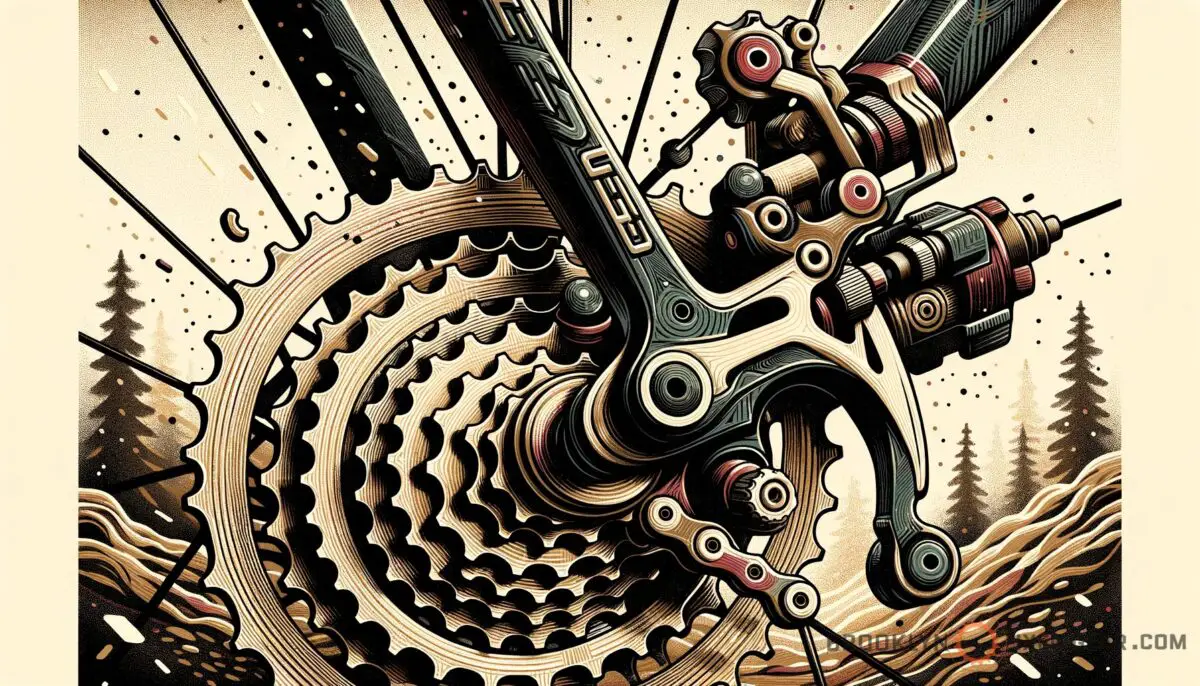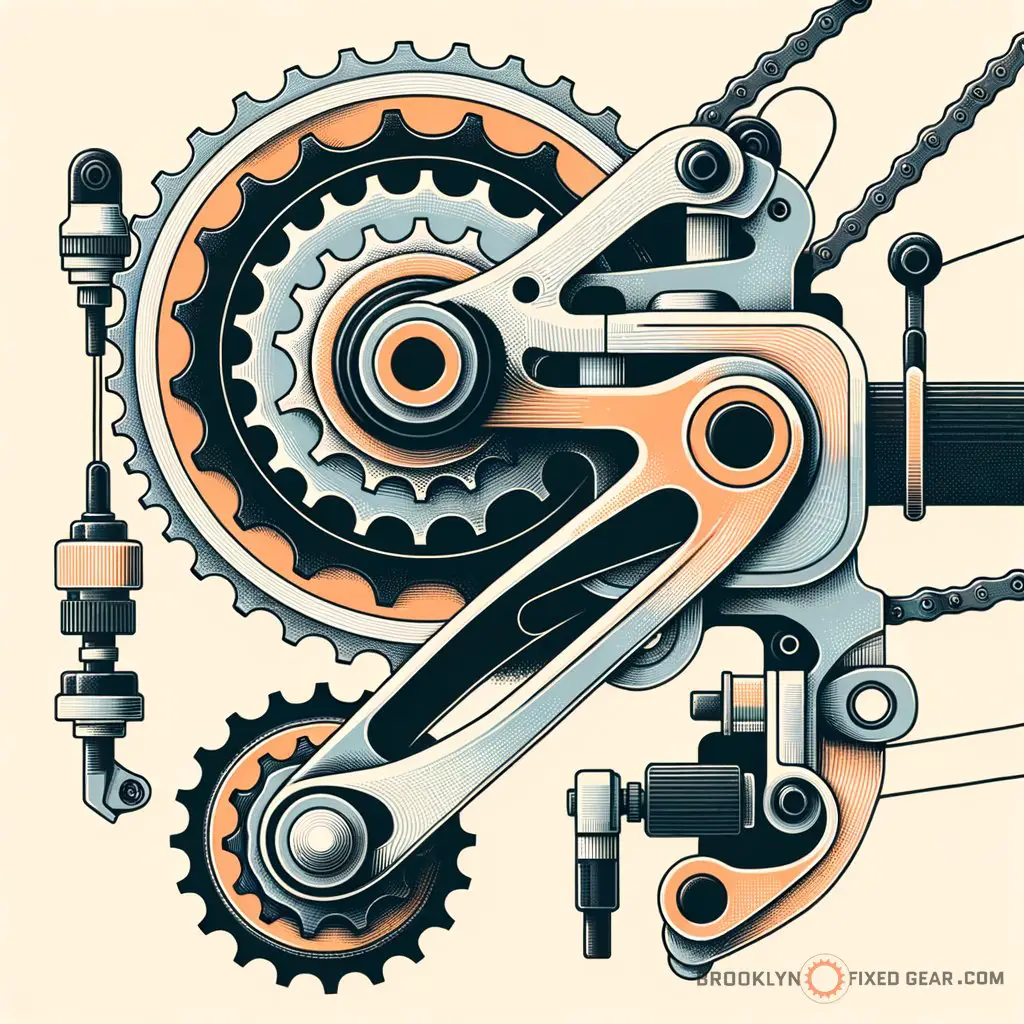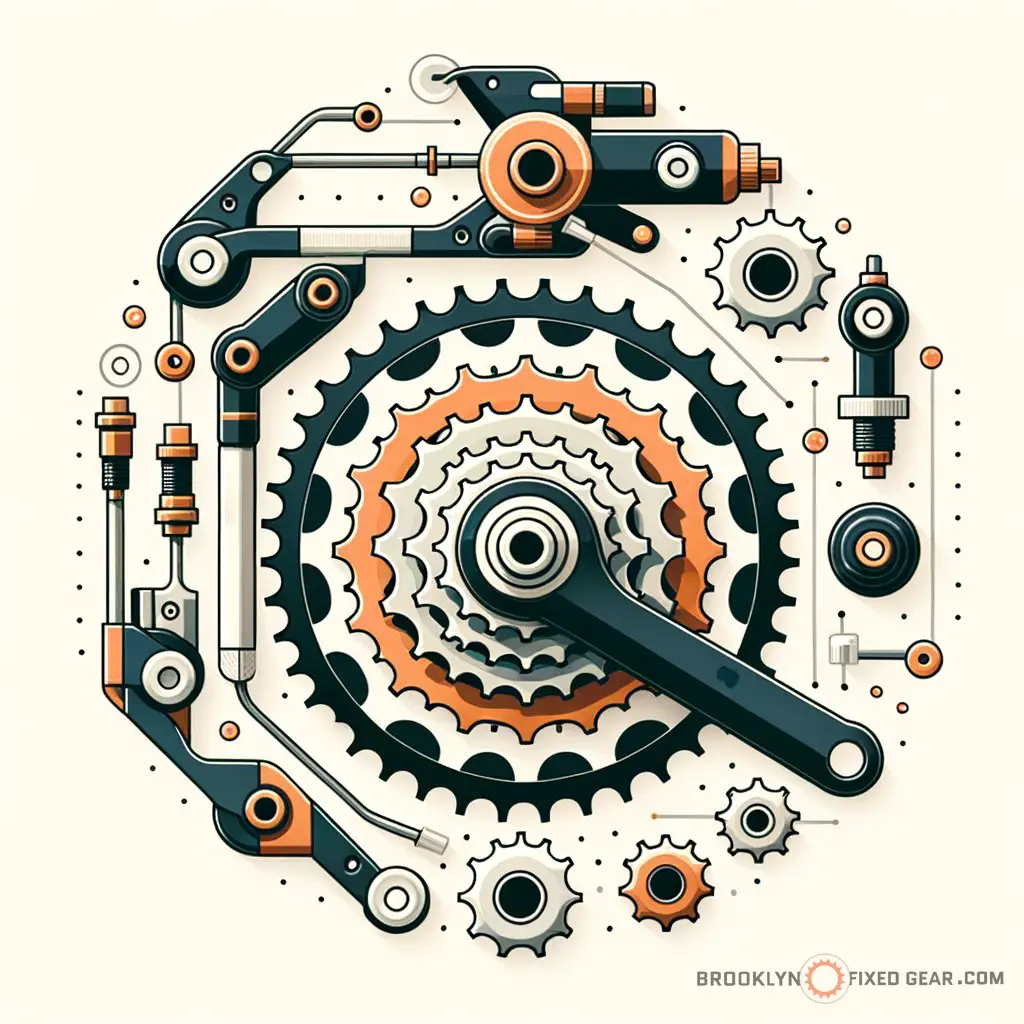Ever wondered what makes road and mountain biek gears shift smoothly? If you’re curious about delving into the world of geared bikes or just clueless about the mechanics, you’ve pedaled into the right place. In the saddle with me, and dive into the cogs and chains of the derailleur.
Key takeaways
- A derailleur shifts gears by moving the bike’s chain between different-sized sprockets.
- Maintenance is crucial for keeping your derailleur in top shape; clean and lube regularly.
- Electronic shifters offer precision shifting but require charging and come at a higher cost.
What is a derailleur?
A derailleur is the heart of a bike’s gearing system, it’s the mechanism that moves the chain from one gear to another. Now, I know what you’re thinking, “Bradley, but you’re all about that fixie life, right?” Hear me out, though – understanding derailleurs can give you a new perspective, even if they’re not your thing.

Derailleurs come in two main types: front and rear. The front derailleur pushes the chain between the rings on the crankset, while the rear derailleur handles the shifting across the cassette. It’s this combo that allows riders to tackle different terrains and speeds.
- Front derailleur: Guides the chain between the chainrings
- Rear derailleur: Moves the chain up and down the cassette
Imagine you’re spinning up a hill; you want an easy gear, right? That’s where a derailleur comes in handy—it effortlessly flicks your chain to a larger cog, making pedaling a breeze. At its core, a derailleur is a device about precision and finesse, ensuring you keep rolling with ease no matter the gradient.
Now, it’s opinion time—just me chatting with you, nothing expert or highfalutin here. Derailleurs, they’re nifty little gadgets that can make riding varied terrain less of a pain. Fixed-gear purists might scoff at them, but they’ve got their place.
That said, nothing beats the raw connection you feel riding a fixie, the simplicity and control—it’s poetry in motion. Plus, it’s no secret that derailleurs can be a bit high-maintenance. I remember a scene from a classic bike messenger movie; one moment, the lead’s flying down the streets of San Francisco, next thing you know, they’re wrestling with a jammed derailleur.
Just goes to show, even Hollywood knows a derailleur can bring about a dramatic twist in any cyclist’s tale. If fixie’s your style, you’re likely nodding along; if not, maybe there’s some allure in checking out how to choose a bike saddle that fits just right for your next ride, gears or no gears.
State Bicycle Co. Black Label 6061

State Bicycle Co. Black Label 6061
Understanding the derailleur
Before you can master the gear changes on a road bike, you need to know what’s happening beneath you. The derailleur is your personal gear shift assistant, whether you’re climbing up a steep incline or cruising on a flat road.
How does a derailleur work?
The magic of the derailleur lies in its ability to tension the chain and guide it between sprockets. By pushing the shifter, you send a signal down the cables to the derailleur, telling it to nudge the chain up or down the gears. It’s all about timing and precision—get it right, and your ride is smooth; get it wrong, and you’ll hear that dreaded clanking sound.

Visit how to replace a bike chain to ensure your chain is always in top shape.
The components of a derailleur system
The derailleur system isn’t a solo act. It’s made up of several key players:
- * Shifters
- * Cables
- * Front derailleur
- * Rear derailleur
- * Chainrings
- * Cassette
Maintaining your derailleur
Keeping your derailleur in good working order means a better riding experience. It might sound like a chore, but trust me, it’s worth the effort.
Routine checks for optimal performance
Regular maintenance includes checking for:
- * Proper derailleur alignment
- * Cable tension and condition
- * Wear and tear on the derailleur’s pulley wheels
Common derailleur issues
It’s not uncommon to experience some problems with your derailleur over time. If shifting becomes erratic or noisy, you might need to adjust the limit screws or cable tension. Dropping chains or struggling to change gears smoothly are also signs that your derailleur may need a little TLC.
Choosing the right derailleur for your bike
Not all derailleurs are created equal. Depending on your ride, you’ll want to pick the right one that can handle your cycling adventures.
Compatibility with your bike
Make sure the derailleur matches:
- * Your bike’s brand and model
- * The number of gears
- * The size of your bike’s frame and wheels
Types of derailleurs
Understanding the differences between short, medium, and long-cage derailleurs will help you choose a component suited to your preference for comfort or performance. Whether you’re a speed demon or a mountain conqueror, there’s a derailleur out there tailored for your style.
Advancements in derailleur technology
The world of cycling is constantly evolving, and derailleur technology is no exception. Let’s take a peek at the future.

Electronic shifting
Enter the era of electronic derailleurs—precise, reliable, and lightning-fast gear changes at the touch of a button. It’s an investment in your cycling future, offering a revolutionary ride quality. Tinker around our section on cycling innovation cost to weigh the pros and cons.
What’s next for the humble derailleur?
As the cycling industry propels forward, we’ll likely see more refinement in weight, efficiency, and overall performance. It’s an exciting time to be a cyclist, watching these advancements unfold.
Here’s a data table highlighting key differences between types of derailleurs to help you make an educated choice:
| Derailleur Type | Gearing Range | Best Use Case | Maintenance Level |
|---|---|---|---|
| Short Cage | Up to 28T max | Road biking | Low |
| Medium Cage | Up to 34T max | Mixed terrain | Moderate |
| Long Cage | 36T and above | Mountain biking | High |
“Regular maintenance and proper care are key to keeping your bike in stellar condition. Precise control over gearing, optimizing pedaling efficiency, and smoother rides are just some of the benefits that come with understanding and using a derailleur system.”
With the variability in maintenance levels and gearing range, knowing your derailleur type can help tailor your bike setup to your preferred riding style.
Choosing the right derailleur can mean smoother rides and less maintenance hassle. Consider gearing range and your biking terrain before making your selection.
More cycling tips
Whether you ride a fixie or you’re just getting acquainted with a geared bike, cycling is all about enjoyment and efficiency. Here are a few tips to keep your rides smooth and your spirits high:
- Always do a quick pre-ride check, especially on your brakes and tires.
- For a comfortable ride, set your saddle to the correct height.
- Keep hydrated, especially on longer rides—your body (and bike) will thank you.
- Stay visible with proper lighting and reflective gear, no matter the time of day.
- Learn basic hand signals for safer rides in traffic.
- Invest in a quality lock and know the best practices to keep your ride secure.
When it comes to taking care of your bike, there are certain dos and don’ts that can make a big difference. Here’s a compact guide to help you stay on track:
| Do | Don’t |
|---|---|
| Regularly clean and lube chain | Ignore strange noises from bike |
| Check tire pressure usually | Skimp on safety gear |
| Learn how to change a flat tire | Leave bike exposed to harsh weather conditions |
| Carry a basic multi-tool | Use WD-40 as a chain lube |
Regular maintenance and proper care are key to keeping your bike in stellar condition.
Advantages and disadvantages of using a derailleur
Gearing up with a derailleur system has its ups and downs. Here’s what you need to consider:
Advantages
- Allows for precise control over gearing, making climbs and sprints easier.
- Wide range of gears gives you versatility for different terrains.
- Generally leads to faster rides due to optimized pedaling efficiency.
- Gear shifting is smoother, giving you a more comfortable ride.
Disadvantages
- More moving parts can lead to increased wear and require more maintenance.
- Derailleurs are prone to damage from impact, which can throw off your ride.
- Adds weight to your bike, which might affect handling.
- Complexity can be daunting for beginners and can lead to shifting issues if not used correctly.
Weighing these pros and cons should give you a clearer idea of whether a derailleur system suits your cycling style.
If you are a visual learner, check out this video titled ‘How Do Bike Gears Work? | Mountain Bike Derailleur Explained’
Frequently asked questions (FAQ)
Can I convert my fixie to a bike with a derailleur?
Yes, you can convert a fixie to a bike with a derailleur, but it’s not a simple switch. You’ll need to make sure your frame has the necessary mounts for a derailleur, replace your rear wheel with one that can accommodate a cassette, and install shifters and cables. Considering the effort and cost, it might be more sensible to invest in a separate geared bike.
How usually should I replace my derailleur?
The lifespan of a derailleur depends on usage and care. If you’re shifting properly and maintaining your bike, a derailleur can last many years. Signs that you might need a replacement include difficulty shifting, persistent noise, or visible damage.
Regular inspections and servicing can help extend its life.
Is an electronic derailleur better than a mechanical one?
An electronic derailleur offers precision and reliability that can be game-changing for serious riders. Shifts are quicker and smoother, with less effort required from the rider. However, they are more expensive and require charging.
For casual riders or those who prefer simplicity, a mechanical derailleur is still a fantastic choice.
Final thoughts
As we coast to a halt on today’s journey, remember that whether you’re a fixed-gear aficionado or a multi-gear cyclist, the derailleur remains a fascinating component, essential for those who prefer geared bikes. Its ability to shift gears adds a layer of complexity but also versatility to your riding experience. Maintenance might be a bit more complex than on a fixie, but the payoff is the freedom to adapt your ride to any terrain.
How do you feel about the derailleur now? Does it seem like a component you’d want to explore more, or are you a fixie rider through and through? Did I cover everything you wanted to know?Let me know in the comments section below—I read and reply to every comment. If you found this article helpful, share it with a friend, and check out my full blog for more tips and tricks on cycling.
Thanks for reading and keep riding with confidence!















